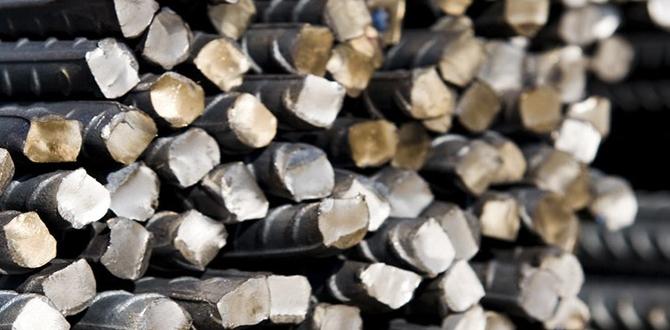Quick Summary: An electric brad nailer is a DIY game-changer for trim, molding, and light woodworking. It’s user-friendly, corded or battery-powered, and offers great precision for clean, professional finishes on your home projects, making DIY tasks faster and easier.
Hey there, DIYers! Jack Shaffer here from Nailerguy. Ever tackled a project where tiny nails just wouldn’t cooperate, or you spent ages with a hammer, only to have things end up a little… crooked? If you’re looking to add trim, build some shelves, or just make your home projects look way more professional without all the fuss, you’re in the right place. Many beginners find nailing things perfectly can be tricky. Hammering nails one by one can be slow and lead to dents or bent nails. This is where a real hero for your toolbox comes in: the electric brad nailer!
This amazing tool can make your DIY dreams a reality with ease. It’s like giving your hands a super-powered upgrade. We’re going to walk through everything you need to know, from what an electric brad nailer actually is to how it can make your next project a breeze. Get ready to nail your next DIY adventure!
Table of Contents
What is an Electric Brad Nailer, Anyway?
Simply put, an electric brad nailer is a power tool designed to drive small, thin nails, called “brads,” into wood. Unlike older pneumatic (air-powered) nailers that need a bulky air compressor and hose, electric versions get their power from either a cord plugged into the wall or a rechargeable battery pack. This makes them incredibly convenient and portable for all sorts of jobs around the house.
Think of it as a super-efficient, automated hammer for small nails. It uses an electric motor or a spring-loaded mechanism to instantly push a brad into your material. This means you get a consistent, clean finish every single time, with minimal effort. No more struggling to hit the nail head just right or worrying about the hose getting in your way.
Why is an Electric Brad Nailer Genius for DIY?
The “genius” part of using an electric brad nailer for DIY projects boils down to a few key benefits that make your life easier:
- Ease of Use: They are incredibly beginner-friendly. You just position the nailer, squeeze the trigger, and bang – you’ve got a nail sunk perfectly!
- Speed and Efficiency: Projects that would take hours with a hammer can be completed in a fraction of the time.
- Precision and Professional Finish: The nails are driven consistently, flush with the surface, giving your work a neat, polished look that’s hard to achieve by hand.
- Versatility: Perfect for installing baseboards, crown molding, window and door trim, attaching cabinet face frames, or even small craft projects.
- Portability: Cordless models mean you can take them anywhere in your home or yard without being tethered to an outlet or compressor.
Types of Electric Brad Nailers
When we talk about “electric” brad nailers, there are a couple of main categories that are important for DIYers to know about. Each has its own advantages, depending on your power source preference and how you plan to use the tool.
1. Corded Electric Brad Nailers
These nailers plug directly into a standard electrical outlet. They rely on a cord to supply continuous power to the firing mechanism.
Pros:
- Generally less expensive upfront than cordless models.
- Unlimited power – as long as you have electricity, you can keep firing nails. No need to worry about battery life.
- Often lighter than battery-powered counterparts because they don’t have the weight of a battery.
Cons:
- You are limited by the length of the power cord and the availability of outlets.
- Managing the cord can be a hassle, especially when working on ladders or in tight spaces.
- Safety can be a concern if the cord is not managed properly, as it can be tripped over or accidentally cut.
2. Cordless Electric Brad Nailers (Battery-Powered)
Gaining huge popularity, these nailers run on rechargeable lithium-ion batteries. They offer true freedom of movement.
Pros:
- Complete freedom of movement – no cords to drag or get tangled.
- Perfect for working in remote areas where power outlets are scarce.
- Extremely convenient for repeated, quick nailing tasks.
- Many battery systems are interchangeable with other tools from the same brand, saving you money in the long run.
Cons:
- Higher initial cost due to the battery and charger.
- You’re limited by battery life. You’ll need to recharge or have spare batteries on hand for longer jobs.
- Can be heavier than corded models due to the battery weight.
For most DIYers looking for maximum convenience and ease of use on a variety of projects, a cordless electric brad nailer is often the way to go. The freedom it offers is unparalleled for home improvement tasks.
Key Features to Look for in an Electric Brad Nailer
Not all electric brad nailers are created equal. When you’re shopping, keep an eye out for these features to ensure you’re getting a tool that fits your needs:
- Nail Compatibility: Ensure the nailer accepts the size and gauge of brads you’ll most often use. Brads come in different lengths (e.g., 3/4 inch to 2 inches) and gauges (thickness). Most DIYers use 18-gauge brads (often called “brad nails”).
- Depth Adjustment: This is crucial! It allows you to control how far into the wood the nail is driven. You want nails to be flush or slightly countersunk, not popping out or driven too deep. Look for tool-free depth adjustment, which is usually a wheel or dial.
- Firing Modes:
- Sequential Firing (Single Shot): You must press the safety contact tip against the surface and pull the trigger to fire one nail. This is safer and allows for precise placement, ideal for detailed trim work.
- Contact Firing (Bump Fire): You can fire nails continuously by holding down the trigger and bumping the safety contact tip against the wood. This is much faster for less critical applications but requires more safety awareness. Many nailers offer a switch to select between these modes.
- Safety Features: Always look for a “contact trip” safety mechanism that prevents accidental firing. A good grip and a well-balanced design also contribute to safer operation.
- Jam Release: Jams happen, especially with any nailer. A tool-free jam release makes it quick and easy to clear a jammed nail without needing extra tools.
- LED Light: Some models have a built-in LED light that illuminates the work area, which is super handy when working in dim light or trying to see precisely where you’re placing a nail.
- Ergonomics and Weight: Since you’ll be holding and operating the tool, a comfortable grip and balanced weight distribution are important, especially for extended use.
How to Use Your Electric Brad Nailer Safely and Effectively
Using power tools can seem intimidating, but with a few simple steps and safety precautions, you’ll be a pro in no time. Remember, safety first!
Step-by-Step Guide to Using Your Electric Brad Nailer
-
Read the Manual: Seriously, even though it seems simple, every tool has its quirks. Your owner’s manual is your best friend for understanding your specific model’s features and safety guidelines. For general safety standards, the Occupational Safety and Health Administration (OSHA) offers excellent guidance on nail gun safety that applies to all types.
-
Put on Safety Gear: Always wear safety glasses or goggles to protect your eyes from flying debris or ricocheting nails. Hearing protection is also a good idea, though electric nailers are generally quieter than pneumatic ones. Gloves can help with grip and keep your hands clean.
-
Load the Nails: Open the magazine (the part that holds the nails). Slide in your brad nails, making sure they are the correct size and gauge and are oriented properly (usually facing the same direction). Close the magazine securely. Most nailers have an indicator to show remaining nail count.
-
Select Firing Mode (if applicable): If your nailer has selectable modes, choose the one you need. For precise work like attaching trim, use sequential firing. For faster work where precision is less critical, contact firing might be suitable, but always engage the safety tip first.
-
Set the Depth Adjustment: Before you start nailing, test the depth on a scrap piece of the same material you’ll be working with. Place the nailer against the scrap wood and fire a nail. Check if it’s flush, slightly below, or too deep. Adjust the depth setting as needed and test again until you achieve the desired result. You want the nail head to be just under the surface of the wood, especially if you plan to paint or finish it.
-
Position the Nailer: Place the tip of the nailer firmly against the surface where you want to drive the nail. Make sure the safety contact tip is pressed flat against the wood to engage the safety mechanism. Keep your fingers away from the trigger and the nose of the tool.
-
Fire the Nail:
- Sequential Mode: First, press the safety contact tip firmly against the surface. Then, pull the trigger.
- Contact Mode: Hold the trigger down, then press the safety contact tip firmly against the surface. The nail will fire. Release the trigger after each nail if you’re not “bumping.”
For precise placement, it’s often best to use sequential mode even for repetitive tasks, as it gives you better control. If using contact mode for speed, ensure you understand the risks and always keep the safety contact engaged on another surface or object when preparing to fire the next nail.
-
Continue Nailing: Move to the next spot and repeat the process. For trim, nails should be placed at regular intervals, typically 12-16 inches apart, and a couple of inches from ends. When nailing near edges, be extra careful not to split the wood. Pre-drilling small pilot holes for brads can help prevent this, especially in hardwoods.
-
Troubleshoot Jams: If a nail gets stuck, first remove the battery or unplug the tool. Then, use the tool-free jam release mechanism to open the nose and remove the obstruction. Refer to your manual for specific instructions.
-
Turn Off and Store: When you’re finished, remove the battery or unplug the tool. Store your electric brad nailer in a clean, dry place, preferably in its original case, to protect it.
Tips for Maximum Efficiency and Great Results
- Use the Right Nails: Always use the gauge and length of brads recommended by the manufacturer for your nailer. Using the wrong size can lead to jams or poor holding power.
- Keep it Clean: Regularly clean the nose of the nailer and the magazine to ensure smooth operation.
- Don’t Force It: If the nail isn’t driving properly, check your depth setting, nail load, and ensure the tool is held flush against the surface.
- Work with the Grain: When possible, aim to drive nails with the wood grain, not across it, for better holding strength and reduced risk of splitting.
- Practice on Scrap: Before diving into your main project, especially if you’re new to the tool, spend a few minutes nailing into scrap wood to get a feel for the depth, trigger control, and firing modes.
- Consider Your Wood: Softer woods are more forgiving. For hardwoods or veneers, be extra careful with depth settings and consider pre-drilling tiny pilot holes for brads to prevent splitting. A specialized finish nailer (which drives slightly thicker nails) might be better for very demanding applications, but for most DIY trim and molding, an 18-gauge brad nailer is perfect.
Common DIY Projects Perfect for an Electric Brad Nailer
The versatility of an electric brad nailer makes it a go-to tool for countless home improvement tasks. Here are some of the most common and satisfying projects you can tackle:
1. Installing Trim and Molding
This is where electric brad nailers truly shine. Whether it’s baseboards, door casings, window trim, or crown molding, a brad nailer makes installation significantly easier and faster. The precise nailing ensures a clean, professional look that’s hard to achieve with a hammer. You can easily secure trim to studs or drywall (with appropriate anchors for things like heavy crown molding) for a secure fit and a polished finish.
2. Building and Installing Cabinetry
For DIY cabinet makers, an electric brad nailer is invaluable. It’s perfect for assembling cabinet face frames, attaching drawer fronts, or even putting together smaller cabinet boxes for utility shelves. The ability to quickly and accurately drive nails helps create strong joints and maintains a clean aesthetic, especially when using nails that can be easily concealed or filled.
3. DIY Furniture and Shelving
Want to build a simple bookshelf, a picture frame, or a small piece of accent furniture? A brad nailer is your best friend. It can help you assemble wooden components quickly and securely. For example, attaching the sides to the shelves of a bookshelf or securing the frame of a small coffee table becomes a straightforward task.
4. Craft Projects and Woodworking Jigs
Beyond home improvement, electric brad nailers are fantastic for smaller-scale woodworking and craft projects. If you’re building decorative items, assembling birdhouses, or creating your own custom woodworking jigs, a brad nailer offers speed and precision for detailed work.
5. Quick Repairs
Have a loose piece of chair trim or a section of fence that needs a quick fix? An electric brad nailer can often be the fastest way to re-secure that small piece of wood without needing a large, cumbersome tool or complicated setup.
The common thread here is that these projects all involve attaching relatively thin pieces of wood where a smaller nail is sufficient. The brad nailer provides the speed, precision, and professional finish that DIYers strive for, turning what could be challenging tasks into rewarding accomplishments.
Comparing Electric Brad Nailers to Other Nailer Types
It’s helpful to understand where the electric brad nailer fits into the broader world of nail guns, so you know why it’s so “essential genius” for many DIY tasks.
| Nailer Type | Power Source | Nail Type | Typical Usage | DIY Friendliness | Pros for DIY | Cons for DIY |
|---|---|---|---|---|---|---|
| Electric Brad Nailer | Corded Electric or Battery | Brads (18-gauge, thin) | Trim, molding, cabinetry, light furniture, crafts | Very High | Easy to use, precise, portable (especially cordless), no compressor needed, fires small nails cleanly. | Limited by nail size and material thickness, can split thin material if not careful. |
| Electric Finish Nailer | Corded Electric or Battery | Finish Nails (16-gauge, slightly thicker than brads) | Wider trim, baseboards, crown molding, furniture building | High | Stronger hold than brad nails, cleaner finish than framing nails, very user-friendly. | Can still split wood, typically more expensive than brad nailers, 16ga nails are more noticeable than 18 ga. |
| Framing Nailer | Pneumatic (Air) or Battery | Framing Nails (large, sturdy) | Building decks, framing walls, fences, heavy-duty construction | Medium | Extremely powerful, fast for heavy-duty jobs. | Overkill for most DIY trim/molding, requires compressor (pneumatic), heavier, more expensive. Often not suitable for delicate work. |
| Stapler (Electric/Pneumatic) | Electric or Pneumatic | Staples (various gauges and widths) | Uphol |




